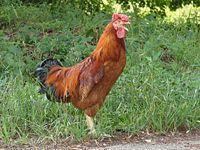
Poltava (chicken)
Encyclopedia

Ukraine
Ukraine is a country in Eastern Europe. It has an area of 603,628 km², making it the second largest contiguous country on the European continent, after Russia...
dual-purpose breed of chicken
Chicken
The chicken is a domesticated fowl, a subspecies of the Red Junglefowl. As one of the most common and widespread domestic animals, and with a population of more than 24 billion in 2003, there are more chickens in the world than any other species of bird...
named after the Ukrainian city of Poltava
Poltava
Poltava is a city in located on the Vorskla River in central Ukraine. It is the administrative center of the Poltava Oblast , as well as the surrounding Poltava Raion of the oblast. Poltava's estimated population is 298,652 ....
. It includes three color varieties: Clay, Cuckoo, and Black.
Breed and variety names
- Ukrainian Names: полтавська (глиняста, зозуляста, чорна)
- English Names: Poltava (Clay, Cuckoo, Black)
- Russian Names: полтавская (глинистая, зозулястая, черная)
Genetic analysis
The Poltava Clay variety was included in the studies of genetic diversity and relationships between various chicken breeds:- Moiseyeva et al. (1994)
- Nikiforov et al. (1998)
- Romanov and Weigend (2001)
- Semyenova et al. (2002)
- Moiseyeva et al. (2003)
- Hillel et al. (2003)
The latter study was done in 1998—2000 within the framework of an international research project entitled «Development of Strategy and Application of Molecular Tools to Assess Biodiversity in Chicken Genetic Resources», or shortly AVIANDIV, that was sponsored by European Commission
European Commission
The European Commission is the executive body of the European Union. The body is responsible for proposing legislation, implementing decisions, upholding the Union's treaties and the general day-to-day running of the Union....
and co-ordinated by Dr. Steffen Weigend, of the Institute for Animal Breeding, Mariensee
Neustadt am Rübenberge
Neustadt am Rübenberge is a town in the district of Hanover, in Lower Saxony, Germany. At 357 km², it is the 9th largest settlement in Germany by area , though only about 45,000 inhabitants live there...
, Germany
Germany
Germany , officially the Federal Republic of Germany , is a federal parliamentary republic in Europe. The country consists of 16 states while the capital and largest city is Berlin. Germany covers an area of 357,021 km2 and has a largely temperate seasonal climate...
.
The AVIANDIV project employed anonymous genetic marker
Genetic marker
A genetic marker is a gene or DNA sequence with a known location on a chromosome that can be used to identify cells, individuals or species. It can be described as a variation that can be observed...
s, so called microsatellite loci
Locus (genetics)
In the fields of genetics and genetic computation, a locus is the specific location of a gene or DNA sequence on a chromosome. A variant of the DNA sequence at a given locus is called an allele. The ordered list of loci known for a particular genome is called a genetic map...
spread across the whole genome
Genome
In modern molecular biology and genetics, the genome is the entirety of an organism's hereditary information. It is encoded either in DNA or, for many types of virus, in RNA. The genome includes both the genes and the non-coding sequences of the DNA/RNA....
. It was shown that 33 populations had no unique allele
Allele
An allele is one of two or more forms of a gene or a genetic locus . "Allel" is an abbreviation of allelomorph. Sometimes, different alleles can result in different observable phenotypic traits, such as different pigmentation...
s, and 14 populations had one unique allele.
External links
- Detailed breed information: Moiseyeva et al. (2006) (in Russian)
- Poltava Clay description: EFABIS; Agriculture Encyclopedia (in Russian)
- Poltava Clay line description:
- Poltava Clay performance: VNITIP.ru

